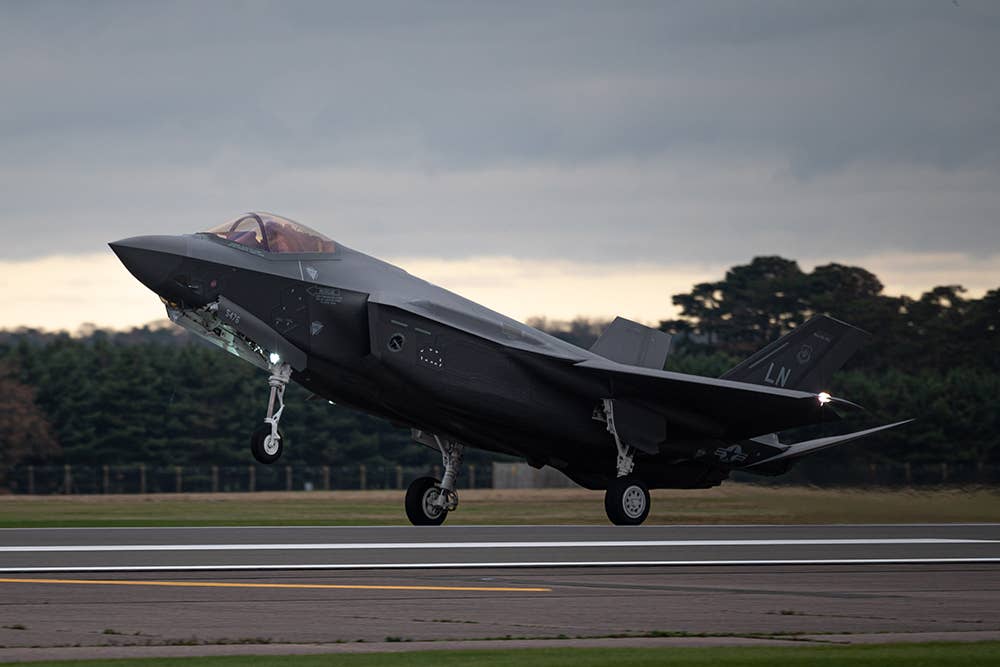Air Force Official: U.S. Needs New F-35 Engine To Prevent ‘Stagnating’
Defense officials are considering replacing the F-35 powerplant with a new engine to increase range, thrust, and power management.

The Air Force, along with the Navy and Marine Corps, announced last month it had grounded the fighters out of an ”abundance of caution.” [Courtesy: USAF]
The U.S. military's advantage in fighter jet propulsion is "essentially stagnating" without a new replacement engine for the Lockheed Martin F-35 Lightning II Joint Strike Fighter, according to a top official at the U.S. Air Force propulsion directorate.
F-35 fighters, which are powered by a Pratt & Whitney F135-PW-100 turbofan engine, are in need of Block 4 upgrades that allow for increased range, thrust, and power management. The Air Force's Adaptive Engine Transition Program (AETP) is considering two potential engines for the modernization effort: the GE Aviation XA100 and Pratt & Whitney XA101. Defense officials are expected to make a final decision on the replacement by Fiscal 2024.
That is, if in fact they pick one at all. Officials could sidestep the AETP option and instead choose the cheaper option of upgrading the fighter's F135 powerplant for more conservative gains in range and thrust.
That choice will dictate the U.S. military's standing when it comes to propulsion, according to John Sneden, director of the U.S. Air Force Life Cycle Management Center’s Propulsion Directorate.
“The perception I think that’s out there is that we’re maintaining, if not advancing, our military advantage in propulsion. And that’s always been because we’ve always had the world’s greatest advantage in propulsion,” Sneden said while at the Air Force’s Life Cycle Industry Days conference last week in Dayton, Ohio. “But the reality is that our lead is starting to—we’re essentially stagnating, and we’re starting to lose.”
F-35 engine sustainment has become a critical issue for the Air Force in recent years. Last year, the service told Congress that about 15 percent of its fleet of 272 F-35A fighters were without engines, due to maintenance delays, Air Force Magazine reported.
A new, adaptive engine for the F-35 would provide fuel efficiency that extends range, as well as increases thrust for combat missions, program officials say. Compared to the F135, prototypes of the XA100 and the XA101 have already demonstrated a 25 percent increase in range, 10 percent increase in thrust, double power management, and are "performing beautifully," Sneden told reporters last week.
Despite the report card, some members of Congress say they’re not in favor of the engine replacement program that comes with an estimated $6 billion price tag.
"The F135 has outperformed its original specifications, including bleed air draw and time on wing, enabling it to support three major airframe and payload upgrades without engine modernization,” said a letter signed by 35 U.S. House members and sent to Undersecretary of Defense for Acquisition William LaPlante last month, Aviation Week reported. “At the same time, the average engine cost has been reduced by more than 50 [percent] to date. Meanwhile, the U.S. services have spent over $7 billion upgrading the airframe and payloads. The current engine can support the upcoming Block 4 air vehicle and payload upgrades. However, there will be an impact to engine life and increased sustainment costs as a result.”
The program cost is only one hurdle for the AETP program. The prototypes won't go into all three variants of the F-35, as they don't support short takeoff and vertical landing capability of the Marine Corps' F-35B variant. Retrofitting U.S. fighters with the adaptive engine could also undermine interoperability among allied air forces.
GE, which touts the drop-in design of its XA100 engine prototype, said its design is compatible with 90 percent of the F-35 program of record and can fit both the Air Force's F-35A and Navy's F-35C carrier variant "without any structural modifications to either airframe."
By contrast, the F135 Enhanced Engine Package, according to Pratt & Whitney, is a low risk, fully Block 4 compatible option that will shave about $40 billion in lifecycle costs over the duration of the program. Upgrading the F135 will also maintain commonality among variants and international partners, the manufacturer said.
Increased performance is worth the cost, Sneden argues.
“You can optimize for performance, or you can optimize for tri-variant commonality,” he told reporters last week. “We think the warfighter deserves the performance attributes that AETP can deliver.”

Sign-up for newsletters & special offers!
Get the latest FLYING stories & special offers delivered directly to your inbox






